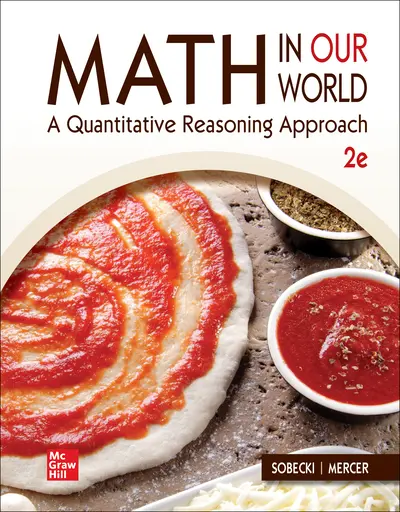My Account Details

ISBN10: 1260727866 | ISBN13: 9781260727869

* The estimated amount of time this product will be on the market is based on a number of factors, including faculty input to instructional design and the prior revision cycle and updates to academic research-which typically results in a revision cycle ranging from every two to four years for this product. Pricing subject to change at any time.
Instructor Information
Quick Actions (Only for Validated Instructor Accounts):
This text exercises students’ brains by challenging them to LEARN, not memorize formulas or mimic procedures. Students will practice reasoning skills and study situations where mathematical thinking can help them be smarter and more successful, both as students and as citizens of society. This text is comprised of a series of activities encouraging students to take responsibility for their learning, with strategically placed solved examples and support to guide them through concepts they may have a hard time discovering on their own.
Unit 1. Mathematical Reasoning and Problem Solving
Lesson 1-1: Inductive and Deductive Reasoning
Lesson 1-2: Estimation and Interpreting Graphs
Lesson 1-3: Problem-Solving Strategies
Unit 2. Consumer Math
Lesson 2-1: Review of Percents
Lesson 2-2: Budgeting
Lesson 2-3: Simple Interest
Lesson 2-4: Compound Interest
Lesson 2-5: Installment Buying
Lesson 2-6: Education and Home Loans
Lesson 2-7: Stocks and Bonds
Lesson 2-8: Income Taxes
Unit 3. Probability
Lesson 3-1: Basic Probability
Lesson 3-2: Sample Spaces and Counting Techniques
Lesson 3-3: Combinatorics
Lesson 3-4: Probability Using Counting Techniques
Lesson 3-5: Odds and Expected Value
Lesson 3-6: Addition Rules for Probability
Lesson 3-7: Multiplication Rules and Conditional Probability
Lesson 3-8: Binomial Probabilities
Unit 4. Statistics
Lesson 4-1: Gathering and Organizing Data
Lesson 4-2: Representing Data Graphically
Lesson 4-3: Measures of Average
Lesson 4-4: Measures of Variation
Lesson 4-5: Measures of Position in a Data Set
Lesson 4-6: Normal Distributions and Z Scores
Lesson 4-7: Applications of the Normal Distribution
Lesson 4-8: Correlation and Regression Analysis
Lesson 4-9: Misuses of Statistics
Unit 5. Math Modeling
Lesson 5-1: Ratios and Proportions
Lesson 5-2: The Basics of Graphing Functions
Lesson 5-3: Modeling with Linear Functions
Lesson 5-4: Modeling with Quadratic Functions
Lesson 5-5: Linear and Quadratic Regression
Lesson 5-6: Modeling with Exponential and Log Functions
Unit 6. Set Theory
Lesson 6-1: The Basics of Working with Sets
Lesson 6-2: Operations on Sets
Lesson 6-3: Studying Sets with Two-Circle Venn Diagrams
Lesson 6-4: Using Sets to Solve Problems
Unit 7. Logic
Lesson 7-1: Statements and Quantifiers
Lesson 7-2: Truth Tables
Lesson 7-3: Types of Statements in Logic
Lesson 7-4: Evaluating Logical Arguments
Unit 8. Measurement
Lesson 8-1: Unit Conversion, Length, and the Metric System
Lesson 8-2: Measuring Area, Volume, and Capacity
Lesson 8-3: Units of Weight and Temperature
Lesson 8-4: Evaluating Efficiency in Packaging
Unit 9: Voting Methods (ONLINE ONLY)
Unit 10: Graph Theory (ONLINE ONLY)
Unit 11: Numeration Systems (ONLINE ONLY)
Accessibility
Creating accessible products is a priority for McGraw Hill. We make accessibility and adhering to WCAG AA guidelines a part of our day-to-day development efforts and product roadmaps.
For more information, visit our accessibility page, or contact us at accessibility@mheducation.com
Need support? We're here to help - Get real-world support and resources every step of the way.